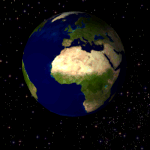
The Large Hadron Collider, a large atom smasher buried underground the French-Swiss border, had already fired its first beam yesterday, September 10, 2008.
Basically, the LHC (Large Hadron Collider) is a huge machine that will make protons collide in order to see what these particles are made of by letting the particles move at a speed nearly equal to the speed of light. After that, the ATLAS and CMS (which are both particle detectors), will detect unusual parictles in the wreckage. With this, the scientists get the answers to the many questions that bothered them for years.
17 miles around. 9,000 magnets. 7,000 scientists. $10 billion. Operating temp: -456.25 F. Power used: 120 MW. Network: 1.8+Gb/s.
Theories that can be answered:
The Big Bang Theory
Best Case: The Large Hadron Colliders' ALICE experiment successfully creates quark-gluon plasma, a substance theorized to have existed just milliseconds after the Big Bang. By generating temperatures more than 100,000 times hotter than the sun, scientists hope to watch as this particle goo cools and expands into the particles that we know. That could help scientists answer why protons and neutrons weigh 100 times more than the quarks they're made of.
Worst Case: Scientists inadvertently make a micro black hole, and the earth is quickly erased from existence. Just kidding: scientists at CERN and elsewhere have ruled out the possibility that the LHC will create any kind of doomsday scenario. The black holes that the LHC could theoretically create don't even have enough energy to light up a light bulb. On the other hand, the U.K.'s Astronomer Royal put the odds of destroying the world at 1 in 50 million (which puts it in the realm of possibilities but still not as likely as hitting the lottery).
String Theory
Best Case: Scientists detect certain types of supersymmetric particles, aka sparticles, which physicist Michio Kaku calls, "signals from the 11th dimension." This would show that string theorists have been on the right path and that the universe really is made up of the four dimensions we experience and then seven others that unite the forces of nature.
Worst Case: String theory's basic assumptions are violated. The LHC will be the first particle accelerator capable of allowing scientists to study W bosons, the elementary particle responsible for the weak force. If they don't scatter in certain ways, it'll be back to the drawing board for a generation of string theorists, or as one physicist told New Scientist, "If we see these violations, people will start working very feverishly on some sort of alternative that will produce these violations."
The "Our Universe Is Not Alone" Theory
Best Case: If scientists find a long-lived gluino, the postulated supersymmetric partner of the gluon, one group of scientists argues that it can be seen as a "messenger from the multiverse" and will lend support to the theory that our universe is just one of many. (Keep in mind though: not everyone is buying this interpretation.)
Worst Case: Our universe really is alone. Or even worse: it's lonely.
The Dark Matter of the Universe Theory
Best Case: Astrophysicists currently believe that 96 percent of the universe is made up of dark matter and energy that we can't see and can barely detect. Dark matter alone is estimated to compose 26 percent of the universe, only we have no idea what it's made of. It has been postulated that the neutralino is the best candidate for dark matter. Many physicists hope that the neutralino -- which, if it exists, will be relatively easy to produce -- will make an appearance in the debris inside the CMS or Atlas detectors, confirming the theory of dark matter.
Worst Case: Proudly, physicists announce that they've observed dark matter's unmistakable signature inside one of the LHC's detectors. But over the next few weeks, the reality sinks in that they've actually made a measurement mistake. Some physicists don't think that the LHC will be precise enough to measure any dark matter that it's lucky enough to create.
The Standard Model of Particle Physics
Best Case: With the standard model so well elucidated, perhaps a curveball is in order. Sean Carroll of Cosmic Variance notes, "There is almost a guarantee that the Higgs exists, or at least some sort of Higgs-like particle," so perhaps the best scenario would be finding the Higgs-like particle rather than the Higgs itself. That wouldn't be such a radical break from the model such that all previous work is too highly devalued, and at the same time it could open new physics frontiers.
Worst Case: The Higgs boson -- the long-postulated particle that is supposed to give mass to particles -- is finally confirmed. Sure, discovering the Higgs at the LHC would be neat, but it would basically just confirm a lot of what physicists already know, without really pushing the science: Boring. Some scientists have even said that their worst case scenario for the entire collider project would be finding the Higgs and just the Higgs.





No comments:
Post a Comment